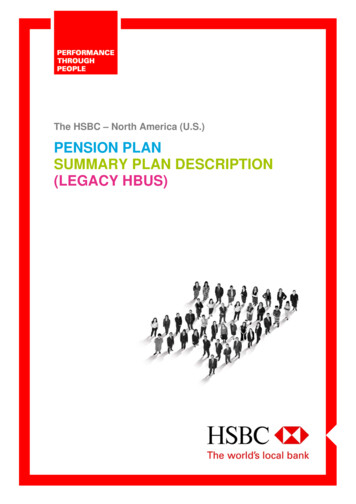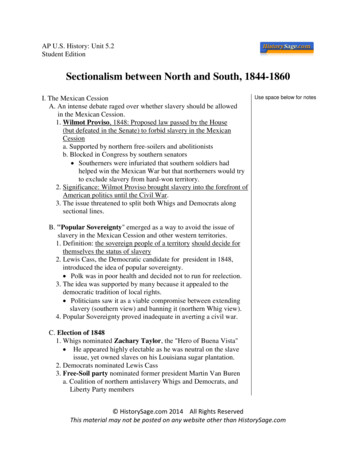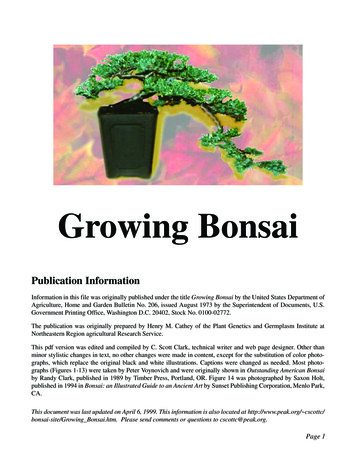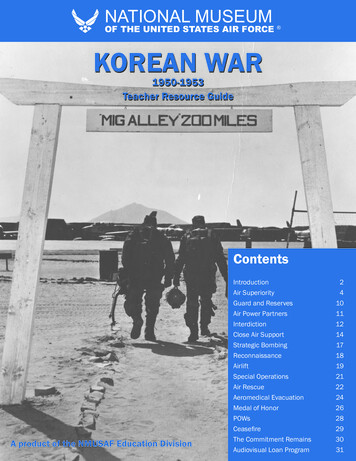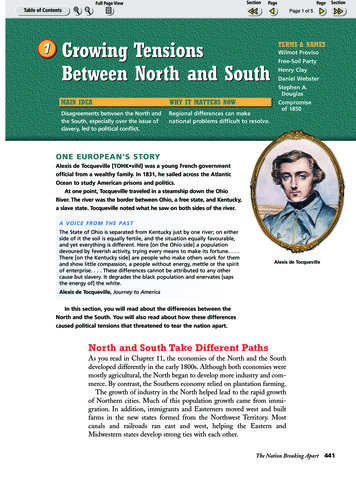
Transcription
440-445US8P R U5C15S1111/26/023:05 PMPage 441Page 1 of 5Growing TensionsBetween North and SouthTERMS & NAMESMAIN IDEAWHY IT MATTERS NOWDisagreements between the North andthe South, especially over the issue ofslavery, led to political conflict.Regional differences can makenational problems difficult to resolve.Compromiseof 1850Wilmot ProvisoFree-Soil PartyHenry ClayDaniel WebsterStephen A.DouglasONE EUROPEAN’S STORYAlexis de Tocqueville [TOHK vihl] was a young French governmentofficial from a wealthy family. In 1831, he sailed across the AtlanticOcean to study American prisons and politics.At one point, Tocqueville traveled in a steamship down the OhioRiver. The river was the border between Ohio, a free state, and Kentucky,a slave state. Tocqueville noted what he saw on both sides of the river.A V O I C E F R O M T H E PA S TThe State of Ohio is separated from Kentucky just by one river; on eitherside of it the soil is equally fertile, and the situation equally favourable,and yet everything is different. Here [on the Ohio side] a populationdevoured by feverish activity, trying every means to make its fortune. . . .There [on the Kentucky side] are people who make others work for themand show little compassion, a people without energy, mettle or the spiritof enterprise. . . . These differences cannot be attributed to any othercause but slavery. It degrades the black population and enervates [sapsthe energy of] the white.Alexis de TocquevilleAlexis de Tocqueville, Journey to AmericaIn this section, you will read about the differences between theNorth and the South. You will also read about how these differencescaused political tensions that threatened to tear the nation apart.North and South Take Different PathsAs you read in Chapter 11, the economies of the North and the Southdeveloped differently in the early 1800s. Although both economies weremostly agricultural, the North began to develop more industry and commerce. By contrast, the Southern economy relied on plantation farming.The growth of industry in the North helped lead to the rapid growthof Northern cities. Much of this population growth came from immigration. In addition, immigrants and Easterners moved west and builtfarms in the new states formed from the Northwest Territory. Mostcanals and railroads ran east and west, helping the Eastern andMidwestern states develop strong ties with each other.The Nation Breaking Apart441
440-445US8P R U5C15S111/26/023:05 PMPage 442Page 2 of 5CONNECT TO HISTORYTradeTrade is based on a simple idea. If you have something someoneelse needs or wants, and that person has something you need orwant, you exchange, or trade, those two things. After the trade,you should both be better off than before.The concept of trade works similarly for groups of people. Forexample, in the early 1800s, the South had few factories. Planterswho wanted manufactured goods usually had to buy them frommanufacturers in the North or in Europe. To have the cash to buythose goods, Southerners sold other goods, such as cotton, to theNorth and other countries. Each sold the goods they could producein order to get money to buy the goods they could not make.1. Solving Problems Whatproblem does trade help acountry solve? How else coulda country solve this problem?See Skillbuilder Handbook,page R18.CONNECT TO TODAY2. Comparing What goodsdo Americans sell to othercountries today? What goodsdo Americans buy from othercountries?For more about trade . . .RESEARCH LINKSCL ASSZONE .COMNorthern States andOther CountriesSouthern StatesThe South developed differently than the North. A few wealthyplanters controlled Southern society. They made great profits from thelabor of their slaves. Much of this profit came from trade. Planters reliedon exports, especially cotton. Because these plantations were so profitable, planters invested in slaves instead of industry. As a result, theSouth developed little industry.Most Southern whites were poor farmers who owned no slaves. Manyof these people resented the powerful slaveholders. But poor whitesaccepted slavery because it kept them off the bottom of society.Antislavery and RacismThe issue of slavery caused tension between the North and the South. Inthe North, the antislavery movement had slowly been gaining strengthsince the 1830s. Abolitionists believed that slavery was unjust and shouldbe abolished immediately. Many Northerners who opposed slavery tooka less extreme position. Some Northern workers and immigrantsopposed slavery because it was an economic threat to them. Becauseslaves did not work for pay, free workers feared that managers wouldemploy slaves rather than them. Some workers were even afraid that theexpansion of slavery might force workers into slavery to find jobs.Despite their opposition to slavery, most Northerners, even abolitionists, were racist by modern standards. Many whites refused to go to442CHAPTER 15A. MakingGeneralizationsHow did theeconomies of theNorth and theSouth differ?A. Answer TheNorth was moreindustrial. TheSouth was moreagricultural andused slave labor.
440-445US8P R U5C15S111/26/02Vocabularyracist: havingprejudice basedon race3:05 PMPage 443Page 3 of 5school with, work with, or live near African Americans. In most states,even free African Americans could not vote.When Northern attacks on slavery increased, slaveholders defendedslavery. Most offered the openly racist argument that white people weresuperior to blacks. Many also claimed that slavery helped slaves by introducing them to Christianity, as well as providing them with food, clothing, and shelter throughout their lives. Slaveholders were determined todefend slavery and their way of life. In this way, the different ideas aboutslavery brought the North and the South into conflict.The Wilmot ProvisoB. RecognizingEffects Whatwere the effectsof the WilmotProviso?B. PossibleResponse Itdivided Congressalong regionallines and led tothe formation ofthe Free-SoilParty.After the Missouri Compromise in 1820, political disagreements overslavery seemed to go away. But new disagreements arose with the outbreak of the War with Mexico in 1846. Many Northerners believed thatSoutherners wanted to take territory from Mexico in order to extendslavery. To prevent that, Representative David Wilmotof Pennsylvania proposed a bill, known as the WilmotProviso, to outlaw slavery in any territory the UnitedStates might acquire from the War with Mexico.EXPANDING SLAVERYBut slaveholders believed that Congress had no rightWilliam Walker, a Tennessee-bornto prevent them from bringing slaves into any of theadventurer, wanted to take overland in Central America. In 1855,territories. They viewed slaves as property. Thehe joined an army of NicaraguanConstitution, they claimed, gave equal protection to therebels and seized power. Walkerproperty rights of all U.S. citizens. The Wilmot Provisodeclared himself president ofNicaragua in 1856. As president,removed the right of slaveholders to take their slaves,he legalized slavery there.which they regarded as property, anywhere in theTroops from nearby countriesUnited States or its territories. Southerners claimed thatdrove him from power in 1857.The actions of men like Walkerthe bill was unconstitutional.helped to convince NorthernersThe Wilmot Proviso divided Congress along regionalthat slaveholders were intent onlines. The bill passed the House of Representatives. Butexpanding slavery beyond theU.S. South.Southerners prevented it from passing the Senate.Even though the Wilmot Proviso never became law,it had important effects. It led to the creation of theFree-Soil Party, a political party dedicated to stoppingthe expansion of slavery. The party’s slogan expressed itsideals—“Free Soil, Free Speech, Free Labor, and FreeMen.” The Free-Soil Party won more than ten seats in Congress inthe election of 1848. More important, the party made slavery a keyissue in national politics. Politicians could ignore slavery no longer.Controversy over TerritoriesBy 1848, the nation’s leaders had begun to debate how to deal with slavery in the lands gained from the War with Mexico. The proposed addition of new states threatened the balance in Congress between North andSouth. The discovery of gold in California brought thousands of peopleinto that territory. There would soon be enough people in California forit to apply for statehood. Most California residents wanted their state toThe Nation Breaking Apart443
440-445US8P R U5C15S111/26/023:05 PMPage 444Page 4 of 5be a free state. But this would tip the balance of power clearly in favor ofthe North. Southerners wanted to divide California in half, making thenorthern half a free state and the southern half a slave state.In 1849, President Zachary Taylor proposed that California submit aplan for statehood that year, without going through the territorial stage.By skipping this stage, Taylor’s plan gave Southern slaveholders littletime to move to California with their slaves.In March 1850, California applied to be admitted as a free state. WithCalifornia as a free state, slave states would become a minority in theSenate just as they were in the House. Jefferson Davis, a senator fromMississippi, warned, “For the first time, we are about permanently todestroy the balance of power between the sections.”BackgroundU.S. land gainsfrom the Warwith Mexicoincluded all orparts of thefuture statesof California,Nevada, Utah,Arizona, NewMexico, andColorado.The Compromise of 1850California could not gain statehood, however, without the approval ofCongress. And Congress was divided over the issue. Behind the scenes,statesmen sought compromise. Taking the lead was Senator Henry ClayJohn C. Calhoun of SouthCarolina opposed theCompromise of 1850. Hebelieved the South hadno reason to compromiseon the issue of slavery.This engraving dramaticallyportrays the Senate debateover the Compromise of 1850.Henry Clay led theCongress in creatingcompromises on severalimportant issues duringhis long career.Daniel Websterspoke eloquentlyin favor of thecompromise.444
440-445US8P R U5C15S111/26/02C. Reading a MapLook at the mapon page 448 tosee how theCompromise of1850 affected theterritories opento slavery.3:05 PMPage 445Page 5 of 5of Kentucky. Clay had helped create the MissouriCompromise in 1820. Now Clay crafted a plan to settlethe California problem.1. To please the North, California would be admitted as a free state, and the slave trade would beabolished in Washington, D.C.2. To please the South, Congress would not pass lawsregarding slavery for the rest of the territories wonfrom Mexico, and Congress would pass a strongerlaw to help slaveholders recapture runaway slaves.Many people on both sides felt they had to give uptoo much in this plan. But others were tired of theregional bickering. They wanted to hold the Uniontogether. Daniel Webster, senator from Massachusetts,supported the compromise for the sake of the Union.A V O I C E F R O M T H E PA S TI wish to speak today, not as a Massachusetts man, nor as aNorthern man, but as an American. . . . I speak today for thepreservation of the Union. Hear me for my cause.Daniel Webster, quoted in The Annals of AmericaThe job of winning passage of the plan fell to SenatorStephen A. Douglas of Illinois. By the end ofSeptember, Douglas succeeded, and the plan, nowknown as the Compromise of 1850, became law.Some people celebrated the compromise, believingthat it had saved the Union. But the compromise wouldnot bring peace. In the next section, you will learn howsectional tensions continued to rise.Section1STEPHEN A. DOUGLAS1813–1861Stephen A. Douglas was one ofthe most powerful members ofCongress in the mid-1800s. In fact,he was called the “Little Giant”because he commanded greatrespect even though he was onlyfive feet four inches tall.Perhaps the most importantissue that Douglas faced duringhis career was the expansion ofslavery into the territories.Douglas privately hated slavery.But he did not believe a debateon morality would do any good.He suggested that the people ofeach territory should decidewhether or not to allow slavery.What groups of Americansagreed with Douglas’sposition on slavery?Assessment1. Terms & Names2. Taking Notes3. Main Ideas4. Critical ThinkingExplain thesignificance of:Use a chart like the onebelow to explain the effectsof each cause.a. What were two ways thatthe North and the South differed by the mid-1800s?Comparing andContrasting How was theCompromise of 1850 similarto and different from theMissouri Compromise? Wilmot ProvisoCausesEffectsFree-Soil PartyAbolitionismHenry ClayWilmot ProvisoDaniel WebsterCalifornia’s applicationStephen A. Douglasfor statehoodCompromise of 1850 Which issue do you thinkmost threatened nationalunity?b. In what ways was racismcommon in both the Northand the South?c. How did the War withMexico lead to conflictbetween the North andthe South?THINK ABOUT the regional tensions atthe time the compromiseswere proposed who proposed each bill the provisions of the billsACTIVITY OPTIONSTECHNOLOGYSPEECHImagine you are a television news director. Plan a five-minute documentary ororganize a panel discussion on the Compromise of 1850.The Nation Breaking Apart445
MAIN IDEA WHY IT MATTERS NOW Growing Tensions Between North and South TERMS & NAMES Wilmot Proviso Free-Soil Party Henry Clay Daniel Webster Stephen A. Douglas Compromise of 1850 North and South Take Different Paths As you read in Chapter 11, the economies of the North and the South de


